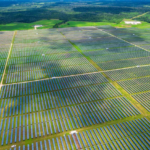Energy News Beat
Texas leads the nation in clean and renewable energy production, and it’s largely due to its geography, federal energy subsidies, deregulated energy market and state-run energy grid.
Texas is one the leading US energy producers — and renewables are a big reason why.
Traditionally considered to be “oil country,” Texas continues to have a heavy fossil fuel presence in the state. Though it may not seem like the likeliest candidate on the surface, the state is a pioneer of clean and renewable energy production. Texas generated roughly 15% of the country’s electricity from all-renewable sources in 2022, according to the Energy Information Association.
While it was wind power that helped blow Texas to the top of the clean energy production charts, increased solar capacity in recent decades has helped its standing. Through 2022, Texas was the second-largest producer of solar energy behind California, according to data from the Solar Energy Industries Association.
Yet, the political pushback happening in Texas could play an outsized role on the future of renewable energy production in the state. While the growth over the past couple of decades is and has been rather remarkable — creating a model that many other states may try to replicate — it has been largely in part due to a unique combination of forces.
Texas’ unique geography, some changes to federal energy subsidies, and a unique mix of deregulated energy and state-wide energy grid, are just a few of the driving forces behind Texas’ developed renewable energy production. But shifts in political influence could change things.
How has Texas become a clean energy leader?
Geography
Experts say that Texas’ ascent to clean energy leader in the US is largely because it’s a geographically large state, and that the western portion of it, in particular, tends to be very windy.
“It is windy in Texas, and particularly windy in West Texas,” said Ross Baldick, PhD, an emeritus professor in the Chandra Family Department of Electrical and Computer Engineering at The University of Texas at Austin, and a Fellow of the Institute of Electrical and Electronics Engineers. Baldick said Texas had an advantage over other parts of the country in harnessing wind power because there were existing transmission capabilities, allowing for the building of turbines and transmission of the resulting electricity to larger cities — such as San Antonio, Houston and Dallas — in the East.
“Most other places that are very windy don’t have many people or transmission” capabilities, he said. “Texas was unique in that it could get things going without having to build transmission” in wind-rich areas.
Besides geography helping Texas become the country’s leading renewable producer, there are a couple of other important factors at play.
Federally funded financial incentives
Federal subsidies played a big role, according to Baldick, which made it more feasible and affordable for wind turbines and wind-power production projects to get off the ground. “Decades ago, the federal government established the production tax credit,” he said. “At the time, the capital cost of building a wind farm was pretty expensive, but by adding subsidies and more, it made it a potentially profitable way to generate electricity.”
Along with federal subsidies and tax credits, an opening up of the wholesale market in Texas was also important.
Deregulated energy market
Texas’ deregulated electricity market and standalone energy grid (called ERCOT, short for the Electric Reliability Council of Texas) created a unique set of economic incentives and opportunities. In short, the deregulated market, combined with special standards concerning ERCOT, allowing almost anyone to enter the grid and contribute to it, allowed many entities to start generating power and supplying it to the rest of the state.
Legislators wanted to spur more development in the relatively sparsely populated western part of the state over the past few decades, and the economic incentives to create wind farms helped lead to economic growth in many areas. Again, though, Baldick said a lot of this comes back to the fact that Texas is naturally windy and had transmission infrastructure in place or easily built — factors that aren’t necessarily present in many other parts of the country.
How does the Texas oil and gas industry affect its renewable industry?
Though Texas has seen immense growth in renewable energy capacity and production over the past couple of decades, the fossil fuel industry is still as powerful a lobby as there is in the state, and it’s throwing its weight around.
Earlier Republican administrations leading the state presided over the fast growth of wind and solar in Texas — including former Governor George W. Bush, who pushed hard for more renewable energy production in the late 1990s. Baldick said, however, that especially over the past few years, “Republican leadership has decided that wind and solar are not what it’s really keen on.”
“If you follow the money and campaign contributions, you might find that natural gas interests have realized that renewables are eating their lunch, and have called in a few favors to try and limit the further growth of renewables,” Baldick said.
There’s something to that hypothesis, too. Data from OpenSecrets shows that 93% of the oil and gas industry’s political contributions to state-level races during the 2022 election cycle went to candidates in Texas, including more than $12.2 million to Governor Greg Abbott. Fossil fuel interests appear to be seeing results, too, as many of the state’s leaders, including Abbott, have increasingly criticized renewables, and have worked to try and pass legislation that would help increase fossil fuel-derived energy production or stymie new wind and solar development.
The future of renewable energy in Texas
While politicians, for the time being, appear to be turning against renewable production in favor of fossil fuels — often along with the public who were calling for fewer renewables in recent years after large storms led to widespread power outages — all things being equal, there’s no reason that Texas can’t continue to see growth in the sector.
The post Texas’ Unique Energy Industry Is Helping the State Become a Renewables Leader appeared first on Energy News Beat.








